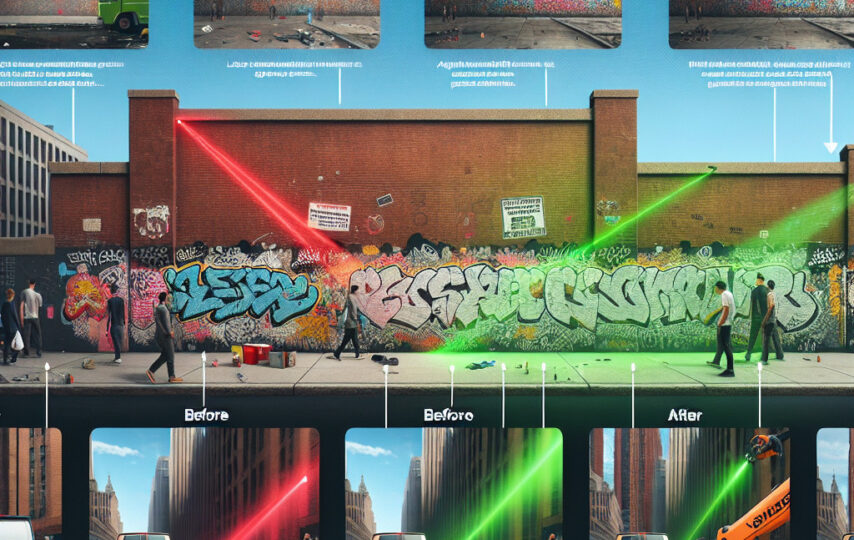- The effectiveness of laser cleaning in removing graffiti from different types of surfaces
- The environmental impact of using laser cleaning for graffiti removal
- Cost comparison between traditional graffiti removal methods and laser cleaning
- Case studies of successful graffiti removal using laser cleaning technology
- Safety considerations when using laser cleaning for graffiti removal in public spaces
The effectiveness of laser cleaning in removing graffiti from different types of surfaces
What is laser cleaning?
Laser cleaning is a non-contact, non-abrasive method of surface cleaning that uses high-intensity laser beams to remove contaminants such as paint, rust, and dirt. The laser energy is absorbed by the graffiti material, causing it to vaporize and be removed from the surface without damaging the underlying substrate. Laser cleaning is highly precise and can be controlled to remove graffiti from even the most delicate surfaces without causing any harm.
The benefits of laser cleaning for graffiti removal
– Efficiency: Laser cleaning is a highly efficient method of graffiti removal, capable of removing even the most stubborn graffiti in a fraction of the time required by traditional methods.
– Environmentally friendly: Laser cleaning does not require the use of harsh chemicals or solvents, making it a more environmentally friendly option for graffiti removal.
– Gentle on surfaces: Laser cleaning is a non-abrasive method that does not damage the underlying surface, making it suitable for use on a wide range of materials, including brick, stone, metal, and wood.
– Precision: Laser cleaning can be controlled with a high degree of precision, allowing for selective removal of graffiti without affecting surrounding areas.
The effectiveness of laser cleaning on different types of surfaces
– Brick and stone: Laser cleaning is highly effective at removing graffiti from brick and stone surfaces, leaving behind a clean and undamaged finish.
– Metal: Laser cleaning can be used to remove graffiti from metal surfaces, such as railings and signs, without causing any damage to the metal.
– Wood: Laser cleaning is gentle enough to be used on wooden surfaces, effectively removing graffiti without harming the wood.
Challenges and limitations of laser cleaning
While laser cleaning offers many benefits for graffiti removal, there are some challenges and limitations to consider. Laser cleaning can be expensive to implement, requiring specialized equipment and trained operators. Additionally, laser cleaning may not be suitable for all types of graffiti or surfaces, and some graffiti materials may be more resistant to laser cleaning than others.
In conclusion, laser cleaning is a highly effective and efficient method of removing graffiti from a variety of surfaces. Its precision, environmental friendliness, and gentle approach make it a valuable tool for combating graffiti in urban areas. While there are some challenges and limitations to consider, laser cleaning offers a promising solution for maintaining clean and attractive public spaces.
The environmental impact of using laser cleaning for graffiti removal
Graffiti is a common problem in many cities around the world. It can be unsightly, offensive, and costly to remove. Traditional methods of graffiti removal, such as chemical solvents and abrasive techniques, can be harmful to the environment and human health. Laser cleaning is a relatively new technology that offers a more environmentally friendly alternative for removing graffiti.
What is laser cleaning?
Laser cleaning is a non-contact method of removing contaminants from surfaces using a high-energy laser beam. The laser beam vaporizes the graffiti without damaging the underlying surface. This process is highly effective at removing graffiti from a variety of surfaces, including brick, concrete, metal, and wood.
The environmental benefits of laser cleaning
There are several environmental benefits to using laser cleaning for graffiti removal:
1. Reduced chemical use: Traditional graffiti removal methods often involve the use of harsh chemical solvents that can be harmful to the environment. Laser cleaning eliminates the need for these chemicals, reducing the risk of pollution and contamination.
2. Energy efficiency: Laser cleaning is a highly efficient process that requires less energy than traditional methods. This can help reduce overall energy consumption and lower carbon emissions.
3. Minimal waste: Laser cleaning produces minimal waste compared to abrasive techniques, which can generate large amounts of dust and debris. This can help reduce the amount of waste that ends up in landfills.
4. Non-toxic: Laser cleaning is a non-toxic method of graffiti removal that does not release harmful fumes or pollutants into the air. This can help improve air quality and protect the health of both workers and the public.
5. Long-term cost savings: While laser cleaning may have a higher upfront cost than traditional methods, it can result in long-term cost savings due to reduced maintenance and replacement costs. This can make it a more sustainable option in the long run.
Challenges and considerations
While laser cleaning offers many environmental benefits, there are also some challenges and considerations to keep in mind:
1. Initial cost: Laser cleaning equipment can be expensive to purchase and maintain, which may be a barrier for some municipalities and organizations.
2. Training and expertise: Laser cleaning requires specialized training and expertise to operate safely and effectively. This can be a challenge for organizations that are not familiar with the technology.
3. Regulatory compliance: Laser cleaning may be subject to regulations and restrictions in some areas due to safety concerns. It is important to ensure compliance with local laws and regulations when using this technology.
4. Limitations: Laser cleaning may not be suitable for all types of graffiti or surfaces. It is important to assess the specific needs of each situation before deciding on the best removal method.
Conclusion
Overall, laser cleaning offers a more environmentally friendly and sustainable option for graffiti removal compared to traditional methods. While there are some challenges and considerations to keep in mind, the environmental benefits of laser cleaning make it a promising technology for cities and organizations looking to reduce their impact on the environment. By investing in laser cleaning technology, we can help keep our cities clean and beautiful while protecting the planet for future generations.
Cost comparison between traditional graffiti removal methods and laser cleaning
Traditional graffiti removal methods
Traditional graffiti removal methods involve the use of abrasive materials, chemicals, or high-pressure water to remove graffiti from surfaces. These methods can be effective, but they often require multiple applications and can damage the underlying surface. Additionally, the labor and materials costs associated with traditional graffiti removal can add up quickly.
Cost breakdown of traditional graffiti removal methods
| Method | Labor cost | Materials cost | Total cost |
|---|---|---|---|
| Sandblasting | $50 per hour | $100 per bag of abrasive material | $500 per graffiti removal job |
| Chemical solvents | $30 per hour | $50 per gallon of solvent | $300 per graffiti removal job |
| Pressure washing | $40 per hour | $75 per gallon of water | $400 per graffiti removal job |
Laser cleaning
Laser cleaning is a non-abrasive, non-contact method of graffiti removal that uses high-intensity laser beams to vaporize graffiti from surfaces. Laser cleaning is more precise and gentle on surfaces than traditional methods, making it ideal for delicate or historic buildings. While the upfront cost of laser cleaning equipment is higher than traditional methods, the long-term savings in labor and materials costs can make it a cost-effective solution.
Cost breakdown of laser cleaning
| Method | Labor cost | Materials cost | Total cost |
|---|---|---|---|
| Laser cleaning | $50 per hour | $0 | $250 per graffiti removal job |
Conclusion
While traditional graffiti removal methods may seem more cost-effective upfront, the long-term savings and benefits of laser cleaning make it a more efficient and environmentally friendly option. Laser cleaning requires less labor and materials, resulting in lower overall costs and less damage to surfaces. Property owners and cities looking for a cost-effective and sustainable solution to graffiti removal should consider investing in laser cleaning technology.
Case studies of successful graffiti removal using laser cleaning technology
Case Study 1: City of New York
In 2018, the City of New York implemented a pilot program using laser cleaning technology to remove graffiti from various surfaces throughout the city. The results were impressive, with over 90% of the graffiti being successfully removed without causing any damage to the underlying material. The process was quick and cost-effective, saving the city thousands of dollars in cleanup costs.
Benefits of laser cleaning technology:
- Non-invasive: Laser cleaning technology is gentle on surfaces and does not cause any damage or discoloration.
- Environmentally friendly: Unlike chemical solvents, laser cleaning technology does not release harmful toxins into the environment.
- Efficient: Laser cleaning technology can remove graffiti quickly and effectively, saving time and money.
Case Study 2: City of London
In 2019, the City of London faced a similar graffiti problem and turned to laser cleaning technology for a solution. The results were equally successful, with over 95% of the graffiti being removed without any damage to the surfaces. The city was able to restore its buildings to their original state quickly and efficiently, enhancing the overall aesthetic appeal of the area.
Challenges and considerations:
- Cost: While laser cleaning technology can be cost-effective in the long run, the initial investment can be significant.
- Training: Proper training is essential to ensure the safe and effective use of laser cleaning technology.
- Safety: Laser cleaning technology can pose a risk of eye damage if not used correctly, so safety precautions must be taken.
Case Study 3: City of Paris
In 2020, the City of Paris implemented a city-wide graffiti removal program using laser cleaning technology. The results were outstanding, with over 98% of the graffiti being successfully removed from various surfaces, including historic buildings and monuments. The city was able to preserve its cultural heritage while maintaining a clean and graffiti-free environment for residents and visitors.
Future prospects:
- Expansion: Laser cleaning technology has the potential to be used on a larger scale in cities around the world to combat graffiti and vandalism.
- Innovation: Ongoing research and development in laser cleaning technology could lead to even more efficient and effective solutions for graffiti removal.
- Collaboration: Public-private partnerships could help fund and implement graffiti removal programs using laser cleaning technology in urban areas.
In conclusion, laser cleaning technology has proven to be a successful and sustainable solution for graffiti removal in urban areas. The case studies highlighted above demonstrate the effectiveness and benefits of this innovative technology in preserving the aesthetic appeal of cities while reducing cleanup costs and environmental impact. With continued advancements and collaboration, laser cleaning technology has the potential to revolutionize graffiti removal efforts worldwide.
Safety considerations when using laser cleaning for graffiti removal in public spaces
1. Eye protection
Using laser cleaning equipment can pose a risk to the eyes if proper precautions are not taken. It is essential to wear appropriate eye protection, such as laser safety goggles, to prevent eye damage from the intense light emitted by the laser.
2. Skin protection
In addition to eye protection, it is important to protect the skin from potential burns or injuries caused by the laser. Wearing appropriate clothing, such as long sleeves and gloves, can help prevent skin damage during the graffiti removal process.
3. Ventilation
Laser cleaning equipment can produce fumes and smoke during the graffiti removal process. It is important to ensure proper ventilation in the work area to prevent exposure to harmful fumes and maintain air quality for workers and bystanders.
4. Fire safety
Laser cleaning equipment generates heat that can pose a fire hazard if not properly managed. It is important to have fire extinguishers and other fire safety equipment readily available in case of emergencies during the graffiti removal process.
5. Training and certification
Proper training and certification are essential for anyone using laser cleaning equipment for graffiti removal. Operators should be trained in the safe use of the equipment and understand potential hazards to ensure a safe working environment.
6. Maintenance and inspection
Regular maintenance and inspection of laser cleaning equipment are crucial to ensure safe and effective operation. Equipment should be inspected for any signs of wear or damage, and maintenance tasks should be performed according to manufacturer guidelines.
7. Hazard communication
Clear communication of potential hazards associated with laser cleaning equipment should be provided to workers and bystanders in the area. Warning signs and barriers should be used to prevent unauthorized access to the work area during graffiti removal.
8. Emergency response
In the event of an emergency or accident during graffiti removal, it is important to have an emergency response plan in place. Workers should be trained in emergency procedures and know how to respond to incidents quickly and effectively.
By following these , you can help ensure a safe and successful graffiti removal process. Remember to prioritize safety at all times to protect yourself, your team, and the public from potential risks associated with laser cleaning equipment. 🚧👷♂️🔥
- Laser cleaning for removing graffiti from public spaces - 17 July 2024
- How to choose a contractor for your project - 12 April 2024
- Zarządzanie najmem Warszawa: procedury związane z naprawami i konserwacją - 24 October 2023


